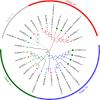Genome-wide identification of HSP90 gene family in Rosa chinensis and its response to salt and drought stresses
- PMID: 39161880
- PMCID: PMC11330952
- DOI: 10.1007/s13205-024-04052-0
Genome-wide identification of HSP90 gene family in Rosa chinensis and its response to salt and drought stresses
Abstract
Heat shock protein 90 (HSP90) is important for many organisms, including plants. Based on the whole genome information, the gene number, gene structure, evolutionary relationship, protein structure, and active site of the HSP90 gene family in Rosa chinensis and Rubus idaeus were determined, and the expression of the HSP90 gene under salt, and drought stresses in two rose varieties Wangxifeng and Sweet Avalanche were analyzed. Six and eight HSP90 genes were identified from R. chinensis and Ru. idaeus, respectively. Phylogenetic analysis revealed that the analyzed genes were divided into two Groups and four subgroups (Classes 1a, 1b, 2a, and 2b). Although members within the same classes displayed highly similar gene structures, while the gene structures and conserved domains of Group 1 (Class 1a and 1b) and the Group 2 (Class 2a and 2b) are different. Tandem and segmental duplication genes were found in Ru. idaeus, but not in R. chinensis, perhaps explaining the difference in HSP90 gene quantity in the two analyzed species. Analysis of cis-acting elements revealed abundant abiotic stress, photolight-response, and hormone-response elements in R. chinensis HSP90s. qRT-PCR analysis suggested that RcHSP90-1-1, RcHSP90-5-1 and RcHSP90-6-1 in Sweet Avalanche and Wangxifeng varieties played important regulatory roles under salt and drought stress. The analysis of protein structure and active sites indicate that the potential different roles of RcHSP90-1-1, RcHSP90-5-1, and RcHSP90-6-1 in salt and drought stresses may come from the differences of corresponding protein structures and activation sites. These data will provide information for the breeding of rose varieties with high stress resistance.
Supplementary information: The online version contains supplementary material available at 10.1007/s13205-024-04052-0.
Keywords: Abiotic stress; HSP90 gene family; Protein active site; Relative expression; Rosa chinensis.
© The Author(s) 2024.
Figures








Similar articles
-
Genome-wide identification and expression analysis of HSP90 gene family in Nicotiana tabacum.BMC Genet. 2019 Mar 19;20(1):35. doi: 10.1186/s12863-019-0738-8. BMC Genet. 2019. PMID: 30890142 Free PMC article.
-
Genome-Wide Analysis of Dof Genes and Their Response to Abiotic Stress in Rose (Rosa chinensis).Front Genet. 2021 Mar 4;12:538733. doi: 10.3389/fgene.2021.538733. eCollection 2021. Front Genet. 2021. PMID: 33747030 Free PMC article.
-
Genome-Wide Identification of the Rose SWEET Gene Family and Their Different Expression Profiles in Cold Response between Two Rose Species.Plants (Basel). 2023 Mar 28;12(7):1474. doi: 10.3390/plants12071474. Plants (Basel). 2023. PMID: 37050100 Free PMC article.
-
Genome-Wide Identification of WRKY Transcription Factor Family in Chinese Rose and Response to Drought, Heat, and Salt Stress.Genes (Basel). 2024 Jun 18;15(6):800. doi: 10.3390/genes15060800. Genes (Basel). 2024. PMID: 38927736 Free PMC article.
-
Genome-wide analysis of the Brachypodium distachyon (L.) P. Beauv. Hsp90 gene family reveals molecular evolution and expression profiling under drought and salt stresses.PLoS One. 2017 Dec 7;12(12):e0189187. doi: 10.1371/journal.pone.0189187. eCollection 2017. PLoS One. 2017. PMID: 29216330 Free PMC article.
Cited by
-
Drought Stress in Roses: A Comprehensive Review of Morphophysiological, Biochemical, and Molecular Responses.Int J Mol Sci. 2025 Apr 30;26(9):4272. doi: 10.3390/ijms26094272. Int J Mol Sci. 2025. PMID: 40362508 Free PMC article. Review.
References
-
- Chen L, Hamada S, Fujiwara M, Zhu T, Thao NP, Wong HL, Krishna P, Ueda T, Kaku H, Shibuya N, Kawasaki T, Shimamoto K (2010) The Hop/Sti1-Hsp90 chaperone complex facilitates the maturation and transport of a PAMP receptor in rice innate immunity. Cell Host Microbe 7:185–196. 10.1016/j.chom.2010.02.008 10.1016/j.chom.2010.02.008 - DOI - PubMed
LinkOut - more resources
Full Text Sources

